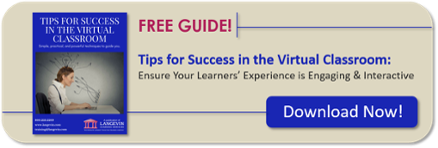
In a typical training course, learners spend significant amounts of time completing skill-based activities and exercises. During those exercises, or upon completion of them, each learner should receive feedback on their performance. In a traditional instructor-led course, the feedback process is fairly straight-forward. In virtual training, however, the process of giving and receiving quality feedback might pose a few challenges.
Having delivered virtual training for a few years, I’ve identified three challenges to providing feedback in the virtual classroom. Keep reading for some effective workarounds.
Challenge: Delivering personalized feedback
One-on-one or small group communication can be a bit more challenging in the virtual classroom. In most cases, the communication is openly broadcast to the entire group of learners. This could pose a challenge when attempting to deliver personalized feedback to an individual or small group.
Fortunately, most platforms have tools like private chat and breakout rooms. To keep the feedback personalized, have a private chat conversation with individual learners. Or, if you must give feedback to multiple groups, try using the breakout room function where only the members of each group are present.
As another option, divide the whiteboard into sections for each small group, or give multiple chat pods a try. I find these techniques also work well when you want your learners to deliver constructive feedback to each other.
Challenge: Encouraging trainees to provide constructive feedback
In both the traditional and virtual classroom setting, the most logical person to deliver feedback is the instructor. While this feedback approach does indeed work, it’s also a good idea to have variety. One option involves the learners giving feedback to each other—peer-to-peer feedback.
As with any training activity, this peer feedback approach must be set up and positioned the right way to be effective. In the virtual environment, the learners may be a bit shy because they’ve never seen or met their peers on the other end of the audio line. Or, some learners may feel they don’t have the appropriate skillset to give quality feedback.
Thankfully, there are workarounds to these issues. As virtual trainers, we should always be building rapport with our learners, both early on and continuously. The incorporation of icebreakers within your virtual course is a good way to do this. An icebreaker allows learners to get more comfortable with each other, increasing their comfort level delivering peer-to-peer feedback.
To remedy the perception of not having the appropriate skillset, always provide your learners with a performance checklist before they are tasked with offering feedback to their peers. This checklist can be part of their electronic manual or downloaded via the file share tool which is typically available on most virtual platforms. A well-designed checklist should provide a specific list of things to do, as well as a list of things to avoid, when delivering effective feedback.
Lastly, you should encourage peer feedback in a group setting within the virtual classroom. Facilitating the peer-to-peer feedback in this manner allows the trainer to oversee the process and provide additional feedback if necessary.
Challenge: Delivering carefully planned feedback
The way in which feedback is delivered in the virtual classroom requires more planning compared to the traditional classroom. The approach depends largely on both your timing constraints and the tools that will be used.
To address this particular challenge, you need to be proactive about how the feedback will be delivered, consider what tools will be required, and prepare effective supplemental materials well ahead of time (if they will be used).
Let’s say you are using a whiteboard for feedback purposes, and that whiteboard will be divided into sections. It’s a good best practice to prepare a slide beforehand so it can be displayed on the whiteboard. Or, if you plan to use multiple chat pods for peer feedback, it’s helpful to create a separate layout ahead of time that contains the number of chat pods required. Likewise, if a performance checklist is required for feedback purposes, it needs to be prepared in advance and included in the participant materials or loaded into a file share pod so it can be distributed to the learners when needed.
Time constraints in the virtual classroom often limit the spontaneous feedback that occurs more easily in the traditional classroom. To help with this, always provide a list of specific questions or criteria so the people providing feedback know exactly what they should be assessing. This list should be prepared in advance, complete with clear instructions and time limits given for each feedback opportunity.
Despite these few challenges, it is indeed possible to give and receive quality feedback in the virtual classroom. Just be sure to account for a few considerations like careful planning and maximizing the use of the tools within your virtual platform. When these things are considered, the feedback approach will be successful.
What challenges have you faced when providing feedback in the virtual classroom? What have you done to overcome those challenges?
Take your virtual classroom courses to the next level with the Maximizing Engagement in the Virtual Classroom workshop. Learn how to leverage the tools in your virtual platform to create powerful, interactive, and engaging virtual learning experiences.
Note: This post is part of a workshop intersession activity. As such, it is monitored in a slightly different manner than the other blog posts on our website. If you are not a participant in the applicable workshop, but have a question you would like answered, please feel free to contact us.



289 Responses to “Overcoming 3 Challenges to Providing Feedback in the Virtual Classroom”
Very insightful look at how to get the learners more involved in the Feedback Process. Until now, I have monopolized this part of my sessions but will make the effort to get the learners more involved, especially in sessions where we are dealing with experienced team members
I’ve seen mixed effects when it comes to peer feedback in virtual environments. In some cases, the factor of anonymity has helped people be more honest. In others, I feel like the less personable feel of the virtual environment makes some people less likely to interact in this way. This article provides some very helpful and actionable ideas, especially the performance checklist! I believe learners would be more comfortable sharing feedback with their peers if they had an objective list of standards or performance expectations they could base their judgments on.
Providing meaningful feedback in virtual training has been a concern for me coming from an ILT background. Such as giving feedback to every learner, as required, when time is limited. Peer-to-peer feedback not only delivers individual feedback, it permits all learners to be actively involved and engaged in the process, and also helps with time efficiency. By selecting the feedback approaches to use in the design phase, and preparing required materials (checklists, slides, instructions, etc.) in advance to pair with selected platform tools; providing effective feedback is now less of a concern for me.
These are great ideas and techniques for eliciting feedback in the virtual classroom. I particularly like the performance checklists.
This was great, full of information I can use during our virtual trainings. Generating a performance checklist in advance can really help peer-to-peer feedback, which is something I would love to incorporate going forward.
This was a great article with some outstanding points as to how to work training in even with the challenges technology can pose. Feedback is an important part of the learning process and we cannot simply set it aside when teaching virtually.
great points in this article. Definitely gives me a lot to think about. Traditionally speaking we have done so many virtual lectures the ONLY feedback we even get is if they have questions. This will be changing now.
We are struggling incorporating feedback into our programs and have been brainstorming ideas. The peer-to-peer feedback is a great idea that I will be bringing back. Thank you.
Providing a performance checklist resonates with me because sometimes those newer or experienced in the role are afraid to look silly or make a mistake. The checklist provides a guide to help them not only use it to provide constructive feedback, but as a resource to ask questions about the expected performance. It helps facilitate conversation which develops into a deeper connection to the content.
This was an interesting article. I think it’s important to build rapport from the beginning so everyone feels more comfortable with each other. I think stressing the importance of positive feedback is also valuable or attendees could get defensive or discouraged. There’s always a way to offer feedback without putting someone down. Offering an alternative way to do something can be helpful. Having a checklist is a good way to stay on topic.